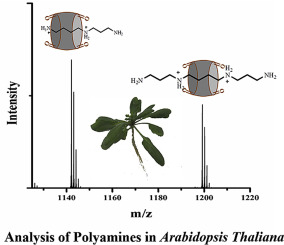当前位置:
X-MOL 学术
›
Anal. Chim. Acta
›
论文详情
Our official English website, www.x-mol.net, welcomes your
feedback! (Note: you will need to create a separate account there.)
Matrix-assisted laser desorption/ionization mass spectrometry for the analysis of polyamines in plant micro-tissues using cucurbituril as a host molecule
Analytica Chimica Acta ( IF 5.7 ) Pub Date : 2017-09-01 , DOI: 10.1016/j.aca.2017.08.027 Jun Ding 1 , Simin Liu 2 , Hua-Ming Xiao 1 , Tian-Tian Ye 1 , Ping Zhou 1 , Yu-Qi Feng 1
Analytica Chimica Acta ( IF 5.7 ) Pub Date : 2017-09-01 , DOI: 10.1016/j.aca.2017.08.027 Jun Ding 1 , Simin Liu 2 , Hua-Ming Xiao 1 , Tian-Tian Ye 1 , Ping Zhou 1 , Yu-Qi Feng 1
Affiliation

|
In this study, a matrix-assisted laser desorption/ionization (MALDI) mass spectrometry (MS) strategy using cucurbit[n]uril (CB[n]) as a host molecule is proposed for the analysis of low molecular weight (LMW) compounds in complex samples. As a proof-of-concept, CB[6] was selected as the host molecule, and endogenous polyamines in plant tissue were chosen as the target analytes. Due to the molecular recognition and mass shifting properties of CB[6], the ionic signals associated with polyamines were moved to the higher mass region (>1000 Da) after specifically binding to CB[6], while signal interference derived from the conventional organic matrix and the complex sample matrix remained in the low mass region because of the incompatibility of their molecular size with CB[6] cavities. The strategy not only facilitated the analysis of LMW compounds in complex samples by MALDI MS, but also offered high throughput by accomplishing the entire analytical procedure within 10 min. The detection of polyamine concentration showed good linearity in the range of 0.02-10.0 ng/μL with correlation coefficients (R) greater than 0.9915. The limits of detection were 8.8-28.8 pg. The good reproducibility and reliability of the method were demonstrated by excellent intraday and interday precisions with relative standard deviations less than 7.9%, and the recovery ranged from 92.1% to 117.1%. Finally, the good sensitivity of the method allowed for the quantitative analysis of endogenous polyamine concentrations in various micro-tissues of Arabidopsis thaliana (20.0-740.0 μg fresh weight for each sample).
中文翻译:

以葫芦脲为主体分子的基质辅助激光解吸/电离质谱分析植物微组织中的多胺
在这项研究中,提出了一种使用葫芦[n]脲(CB[n])作为主体分子的基质辅助激光解吸/电离(MALDI)质谱(MS)策略,用于分析低分子量(LMW)化合物在复杂的样本中。作为概念验证,选择CB[6]作为宿主分子,选择植物组织中的内源多胺作为目标分析物。由于 CB[6] 的分子识别和质量转移特性,与多胺相关的离子信号在与 CB[6] 特异性结合后被移动到更高质量区域(>1000 Da),而信号干扰来自传统有机基质和复杂样品基质由于其分子大小与 CB[6] 腔的不相容性而保持在低质量区域。该策略不仅促进了 MALDI MS 对复杂样品中的 LMW 化合物的分析,而且通过在 10 分钟内完成整个分析过程提供了高通量。多胺浓度的检测在0.02-10.0 ng/μL范围内表现出良好的线性,相关系数(R)大于0.9915。检测限为 8.8-28.8 pg。该方法具有良好的重现性和可靠性,日内和日间精密度优异,相对标准偏差小于 7.9%,回收率在 92.1% 至 117.1% 之间。最后,该方法的良好灵敏度允许定量分析拟南芥各种微组织中的内源多胺浓度(每个样品的鲜重为 20.0-740.0 μg)。还通过在 10 分钟内完成整个分析过程提供了高通量。多胺浓度的检测在0.02-10.0 ng/μL范围内表现出良好的线性,相关系数(R)大于0.9915。检测限为 8.8-28.8 pg。该方法具有良好的重现性和可靠性,日内和日间精密度优异,相对标准偏差小于 7.9%,回收率在 92.1% 至 117.1% 之间。最后,该方法的良好灵敏度允许定量分析拟南芥各种微组织中的内源多胺浓度(每个样品的鲜重为 20.0-740.0 μg)。还通过在 10 分钟内完成整个分析过程提供了高通量。多胺浓度的检测在0.02-10.0 ng/μL范围内表现出良好的线性,相关系数(R)大于0.9915。检测限为 8.8-28.8 pg。该方法具有良好的重现性和可靠性,日内和日间精密度优异,相对标准偏差小于 7.9%,回收率在 92.1% 至 117.1% 之间。最后,该方法的良好灵敏度允许定量分析拟南芥各种微组织中的内源多胺浓度(每个样品的鲜重为 20.0-740.0 μg)。多胺浓度的检测在0.02-10.0 ng/μL范围内表现出良好的线性,相关系数(R)大于0.9915。检测限为 8.8-28.8 pg。该方法具有良好的重现性和可靠性,日内和日间精密度优异,相对标准偏差小于 7.9%,回收率在 92.1% 至 117.1% 之间。最后,该方法的良好灵敏度允许定量分析拟南芥各种微组织中的内源多胺浓度(每个样品的鲜重为 20.0-740.0 μg)。多胺浓度的检测在0.02-10.0 ng/μL范围内表现出良好的线性,相关系数(R)大于0.9915。检测限为 8.8-28.8 pg。该方法具有良好的重现性和可靠性,日内和日间精密度优异,相对标准偏差小于 7.9%,回收率在 92.1% 至 117.1% 之间。最后,该方法的良好灵敏度允许定量分析拟南芥各种微组织中的内源多胺浓度(每个样品的鲜重为 20.0-740.0 μg)。该方法具有良好的重现性和可靠性,日内和日间精密度优异,相对标准偏差小于 7.9%,回收率在 92.1% 至 117.1% 之间。最后,该方法的良好灵敏度允许定量分析拟南芥各种微组织中的内源多胺浓度(每个样品的鲜重为 20.0-740.0 μg)。该方法具有良好的重现性和可靠性,日内和日间精密度优异,相对标准偏差小于 7.9%,回收率在 92.1% 至 117.1% 之间。最后,该方法的良好灵敏度允许定量分析拟南芥各种微组织中的内源多胺浓度(每个样品的鲜重为 20.0-740.0 μg)。
更新日期:2017-09-01
中文翻译:

以葫芦脲为主体分子的基质辅助激光解吸/电离质谱分析植物微组织中的多胺
在这项研究中,提出了一种使用葫芦[n]脲(CB[n])作为主体分子的基质辅助激光解吸/电离(MALDI)质谱(MS)策略,用于分析低分子量(LMW)化合物在复杂的样本中。作为概念验证,选择CB[6]作为宿主分子,选择植物组织中的内源多胺作为目标分析物。由于 CB[6] 的分子识别和质量转移特性,与多胺相关的离子信号在与 CB[6] 特异性结合后被移动到更高质量区域(>1000 Da),而信号干扰来自传统有机基质和复杂样品基质由于其分子大小与 CB[6] 腔的不相容性而保持在低质量区域。该策略不仅促进了 MALDI MS 对复杂样品中的 LMW 化合物的分析,而且通过在 10 分钟内完成整个分析过程提供了高通量。多胺浓度的检测在0.02-10.0 ng/μL范围内表现出良好的线性,相关系数(R)大于0.9915。检测限为 8.8-28.8 pg。该方法具有良好的重现性和可靠性,日内和日间精密度优异,相对标准偏差小于 7.9%,回收率在 92.1% 至 117.1% 之间。最后,该方法的良好灵敏度允许定量分析拟南芥各种微组织中的内源多胺浓度(每个样品的鲜重为 20.0-740.0 μg)。还通过在 10 分钟内完成整个分析过程提供了高通量。多胺浓度的检测在0.02-10.0 ng/μL范围内表现出良好的线性,相关系数(R)大于0.9915。检测限为 8.8-28.8 pg。该方法具有良好的重现性和可靠性,日内和日间精密度优异,相对标准偏差小于 7.9%,回收率在 92.1% 至 117.1% 之间。最后,该方法的良好灵敏度允许定量分析拟南芥各种微组织中的内源多胺浓度(每个样品的鲜重为 20.0-740.0 μg)。还通过在 10 分钟内完成整个分析过程提供了高通量。多胺浓度的检测在0.02-10.0 ng/μL范围内表现出良好的线性,相关系数(R)大于0.9915。检测限为 8.8-28.8 pg。该方法具有良好的重现性和可靠性,日内和日间精密度优异,相对标准偏差小于 7.9%,回收率在 92.1% 至 117.1% 之间。最后,该方法的良好灵敏度允许定量分析拟南芥各种微组织中的内源多胺浓度(每个样品的鲜重为 20.0-740.0 μg)。多胺浓度的检测在0.02-10.0 ng/μL范围内表现出良好的线性,相关系数(R)大于0.9915。检测限为 8.8-28.8 pg。该方法具有良好的重现性和可靠性,日内和日间精密度优异,相对标准偏差小于 7.9%,回收率在 92.1% 至 117.1% 之间。最后,该方法的良好灵敏度允许定量分析拟南芥各种微组织中的内源多胺浓度(每个样品的鲜重为 20.0-740.0 μg)。多胺浓度的检测在0.02-10.0 ng/μL范围内表现出良好的线性,相关系数(R)大于0.9915。检测限为 8.8-28.8 pg。该方法具有良好的重现性和可靠性,日内和日间精密度优异,相对标准偏差小于 7.9%,回收率在 92.1% 至 117.1% 之间。最后,该方法的良好灵敏度允许定量分析拟南芥各种微组织中的内源多胺浓度(每个样品的鲜重为 20.0-740.0 μg)。该方法具有良好的重现性和可靠性,日内和日间精密度优异,相对标准偏差小于 7.9%,回收率在 92.1% 至 117.1% 之间。最后,该方法的良好灵敏度允许定量分析拟南芥各种微组织中的内源多胺浓度(每个样品的鲜重为 20.0-740.0 μg)。该方法具有良好的重现性和可靠性,日内和日间精密度优异,相对标准偏差小于 7.9%,回收率在 92.1% 至 117.1% 之间。最后,该方法的良好灵敏度允许定量分析拟南芥各种微组织中的内源多胺浓度(每个样品的鲜重为 20.0-740.0 μg)。











































 京公网安备 11010802027423号
京公网安备 11010802027423号